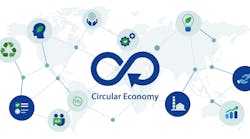As recently reported by LEDs Magazine, a consensus now exists among leading scientists that light fixtures and lamps should be designed to support healthy circadian rhythms. Surveying 248 scientists, who have collectively published 2,697 peer-reviewed scientific articles on circadian clocks and light, Circadian Light Research Center and its academic partners found 24 conclusions emerged, including:
- The widespread introduction of circadian lighting that adjusts light intensity and blue content across day and night can maintain robust circadian entrainment and health.
- The most potent wavelengths for daytime circadian entrainment are 460–495-nm blue light near the sensitivity peak of the ipRGC melanopic receptors.
- LED lights with high 460–495-nm blue content should carry the warning label “may be harmful if used at night.”
Now that the scientific community has spoken, where does the lighting industry go from here?
The industry must collaboratively define evidence-based circadian lighting and deter unsubstantiated "circadian lighting" product claims.
Learn from other industries
Many industries have been confronted with inconvenient truths about newly discovered harmful effects of their products or business practices. How they responded and managed the issue played a large role in determining whether they avoided public relations and market setbacks, cumbersome regulations, or expensive legal judgments. Whether we are discussing the carcinogenicity of flame retardants in fabrics, PFAS chemicals in nonstick Teflon pans, or the ozone layer destruction by the fluorocarbons used as air-conditioner refrigerants, the responses from industry typically can be described in one of three ways:
- Denial — with or without denigrating those who raise the health concerns.
- Acknowledge but ignore — stating that the data is inconclusive and needs further research.
- Accept — and proactively develop a solution or replacement and communicate it effectively.
The first two responses may be reasonable if the data is limited or questionable. However, if pursued too far, such strategies can result in asbestos-scale liabilities or draconian regulations, if the scientific community broadly agrees a health hazard exists but is subsequently ignored.
A proactive response example comes from the petroleum industry. Circadian and sleep scientists in the 1990s had linked certain extended work schedules to a high risk of fatigue-related human errors. They showed that the risks could be successfully mitigated by using fatigue risk management systems (FRMS). Following a 2005 refinery explosion caused by operator fatigue, the oil companies came together under the American Petroleum Institute (API) and rapidly took charge of managing the risks of human fatigue. They avoided government regulations by developing their own RP 755 ANSI standards for FRMS.
Other industries, such as aviation, took no such proactive steps. After pilot fatigue caused an aircraft crash in 2009, Congress imposed a new law mandating fatigue risk management with no industry input.
LED spectral engineering has enabled the development of white light with little or no blue content for nocturnal use.
What’s the best strategy?
Given the broad scientific consensus on circadian lighting, the impact of blue light wavelengths on circadian rhythms and health is undeniable. Even among scientists who can only justify funding when the research outcome is uncertain, 93% of survey respondents agreed that the most potent wavelengths for daytime circadian entrainment are 460–495-nm blue, and 85% confirmed that blue light at night disrupts circadian rhythms. They also agreed that circadian disruption by light at night is associated with significantly increased rates of obesity, diabetes, and breast cancer. Furthermore, 93% agreed that increasing the energy efficiency of lights is desirable, but not if it increases the risks of circadian disruption and serious illness.
The development of blue-chip LEDs has revolutionized lighting and enabled enormous improvements in energy efficiency and product lifetime. From 1% market share in 2013, LED sales have grown to over 80% market share today. However, less than 0.5% of these LED lights modify light intensity and blue content by time of day. While we need to limit the use of blue-chip LEDs to daylight hours, the good news is that LED spectral engineering has enabled the development of white light with little or no blue content for nocturnal use.
Five recommendations to address circadian lighting
How can the $100 billion global lighting industry minimize its liability by smoothly transitioning to circadian-modulated lighting to protect end user health and wellbeing? Next, I share lessons from my experience of advising the API as it took charge of the petrochemical industry’s transition to FRMS.
Move quickly. As soon as employee fatigue and circadian disruption was identified as a key contributor to major accidents, the API formed a task force of senior health and safety executives from major oil companies — including ExxonMobil, Chevron, Shell, and BP — and representatives from other industry associations and agencies. The API did not require all major oil companies to participate but ensured an adequate and influential quorum. The API also preempted regulatory intervention by broadly communicating the industry’s risk management plan.
Hold hearings. The API invited scientific and other subject matter experts to present the relevant research and the available evidence-based solutions. It was important to avoid undue influence from any one self-interest group — that might promote a specific scientific paradigm or model — by ensuring that representatives of all significant stakeholder groups could participate and be heard.
Translate the scientific input into actionable, pragmatic conclusions. Many scientists enjoy debating esoteric and abstruse details. In contrast, the API task force focused on clarifying what was important, proven, and could be acted upon from the science, and what scientifically validated information could be reasonably put into practice.
Draft an ANSI standard for the industry. The API task force developed a consensus document that defined the problem, appropriate nomenclature, and practical steps to introduce and comply with the scientifically based solution — in this case, the FRMS for the petrochemical industry. The standard was circulated to the industry and other stakeholders for comment, and comments were systematically addressed.
Publish and commit to reexamine in five years. The participants fully understood that operational and implementation experience and new scientific discoveries would necessitate updates and changes to the standard. The API published the first RP 755 standard for FRMS in 2010; the latest revision is dated 2019. Notably, based on advances in circadian science, the 2019 RP 755 standard added the requirement that “light sources at night should minimize circadian disruption.”
Apply lessons to lighting
Many of these lessons apply to managing the transition of the lighting industry to healthy, circadian-modulated lighting. The industry will benefit from taking proactive measures before pressure builds to regulate and before a liability develops because of a failure to implement healthy lighting. Above all, the industry must define evidence-based circadian lighting and deter unsubstantiated “circadian lighting” product claims. Genuine adverse health consequences can occur if lighting products are falsely marketed as circadian. The Federal Trade Commission has fined companies marketing other devices and products with unsubstantiated health-related claims.
A lighting industry task force should manage the influence of Department of Energy policies and rules that are setting lumens-per-watt goals that do not take health into account. Input from various scientific groups — which separately advise key industry organizations such as the Illuminating Engineering Society, CIE, and UL — should be included in the discussion and help drive toward consensus for standardization of metrics and models.
Conclusion
The survey of circadian scientists, “Lights Should Support Circadian Rhythms: Evidence-backed Scientific Consensus,” shows that respondents agree on the basic notion that blue wavelengths are required during the day but must be removed in the evening hours. Methods for implementing circadian lighting include spectral engineering, color tuning, dimming, or combinations of these technologies, but they will require standardization to ensure effectiveness. Intellectual property licensing may enable manufacturers to offer scientifically validated circadian lighting, and standards training for lighting designers will be key. But we ought to develop an industry strategy to manage the transition to circadian lighting.
Now that the scientific community has agreed on the need for circadian-modulated lighting, this is the pivotal time for the lighting industry to harvest a commercial opportunity and greatly limit future liability.
The author’s affiliated organization researches and develops circadian lighting technology for the commercial market.
MARTIN MOORE-EDE, MD, PhD, the CEO of CIRCADIAN® and director of the Circadian Light Research Center, was also the founder of Circadian ZircLight, which was acquired in 2022 by Korrus, Inc., where he now serves as chief medical advisor. For decades, Moore-Ede has been leading research on circadian clocks and their entrainment and disruption by light. At the Circadian Light Research Center, he leads the medical research validation of spectrally engineered chips and luminaires that precisely time the delivery of circadian blue wavelengths to boost daytime productivity, minimize circadian disruption, and remove the effects of circadian blue light at night.
Follow our LinkedIn page for our latest news updates, contributed articles, and commentary, and our Facebook page for events announcements and more. You can also find us on Twitter.





